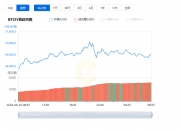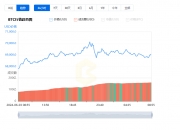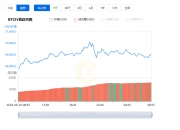生态共荣模型或将驱动Web3.0生态高速高质量发展。我们将Web3.0定义为后端生产关系的创新,其缘起于对Web2.0超级平台模式生态不平衡的变革。然而,随着互联网变成各行各业的基础设施,我们可以预见Web3.0未来不会是仅仅对于某一个特定行业的改变和替代,而是为各行各业发展提出“生态共荣”成长模型的解决方案,其核心特征包括开放(代码开源,降低技术门槛;进入身份无门槛,嫁接全社会优质资源)、共荣(基于Token经济学实现生态各个参与方利益一致)、核心环节自治(基于区块链不可篡改的信任机制,让组织进步更加可持续)。长期看,我们认为更自由、利益分配更合理的生产关系有望推动新一轮自下而上的科技创新。
However, as the Internet becomes an infrastructure for all sectors, we can foresee that Web3.0 will not be a solution to change and replace a particular industry in the future, but rather to propose a “ecological co-optimal” growth model for development in all walks of life, the core features of which include openness (open source, lower technology thresholds, no threshold for access to quality resources in society), co-alignment (consistency of ecological interests based on Token economics), core chain autonomy (resistible confidence mechanisms based on the unalterable chain of blocks, making organizational progress more sustainable). In the long run, we believe that a more freer and more rational production relationship is expected to drive a new round of technological innovation from the bottom up.
DAO是生态共荣模型的核心载体。相比于历史上类似的合作组织、开源软件开发等类似的组织形式,Web3.0提出一套新的解决方案,就是去中心化自治组织(简称DAO),又可以被称为基于某种协作目的的社区。DAO的整体生态目前可分为DAO底层基础设施、应用类DAO,基础设施为DAO建设的辅助工具,未来破圈还需仰仗应用类DAO的发展。DAO目前处于初级发展阶段,根据DeepDAO数据显示,总拥有的资产总额今年6月达85亿美元,呈现良好发展态势,活跃参与社区治理的人数为67.8万人,超过100人持有治理代币的DAO组织为629个。
从Uniswap DAO的案例看社区共荣模型发展路径。任何生态型的产品(包含开发者、C端用户、创作者、投资者等环节)最终都可以以DAO的形式进入生态共荣模型,但是好的产品仍然是生态共荣模型的根基。我们将社区DAO的发展分为三个阶段:1.初期以打造产品为主,这时DAO与传统公司形态无异,需要创始团队前瞻决策,比如Uniswap初期重点打造基于AMMs的去中心化交易所产品;2.逐步培养社区,可以开始建立Token激励体系,吸引一部分社区重要成员参与治理;3.Exit to Community,将社区核心治理权通过Token归还给生态,创始团队可能仍是中心级的存在,但没有绝对掌控权,比如Uniswap将其代币UNI大部分发行给了社区,并通过UNI激励社区成员参与治理。
In the case of Uniswap DAO, the community co-optimal model development path is seen in the case of . Any eco-type product (including developers, C-end users, creators, investors, etc.) can eventually enter the eco-coupled model in the form of DAO, but the good product remains the foundation of the eco-coupled model. We divide the community DAO development into three phases: 1. Initially, the product-making pattern of DAO with the traditional company is the same, and there is a need for proactive decision-making by the founding team, such as Uniswap's initial focus on developing decentralized exchange products based on AMMs; 2. Progressive development of the community, which can start with the establishment of a Token incentive system that attracts key members of the community to participate in governance; 3.Exit to Community, returning the community's core governance to the ecology through Token, which may still exist at the centre level, but without absolute control, such as Uniswap, which distributes most of its tokens UNI to the community and inspire community members to participate in governance through UNI.
DAO目前问题和风险。DAO目前仍处于早期阶段,面临诸多问题,例如在全球大多数地方仍未获得监管认可,运营存在法律风险;核心决策机制不完善,具体又可分为体系内风险(如少数人合谋,多数欺负少数)和体系外风险(比如贿赂选票等),风险潜在解决方案包括改变驱动的治理形式、投票方法或规则来解决。我们建议用开放心态看待DAO的发展,在发展中解决问题,或许是DAO未来正确发展之路。风险:DAO组织形式不受监管法律认可风险;决策机制不完善导致运行失败风险;代码漏洞、体制机制不健全导致金库被攻击风险。
Web3.0缘起是建立更公平、平等的生产关系
Web3.0是基于区块链技术,具有去中心化和Token经济激励体系的新型生产关系,是下一代互联网迭代方向。在元宇宙世界中,革新同时发生在前端与后端。与AR/VR等前端创新不同,Web3.0更加聚焦后端生产关系的更新,随着区块链、加密货币、去中心化应用、DeFi等生态逐步成熟,Web3.0迅速崛起。2022年3月,美国总统拜登签署了行政令[1],在对Web3.0进行审慎监管同时强调美国必须引领Web3.0趋势发展,也侧面说明行业趋势和重要性。
Web3.0 is based on block chain technology, with new production relationships for decentralisation and the Token economic incentive system, and the next generation of the Internet. In the metaspace world, innovation occurs both at the front end and back end. Unlike innovations at the front end, such as AR/VR. Web3.0 focuses more on the renewal of back end production relationships, and web3.0 rises rapidly with ecological maturity such as block chains, encrypted currency, decentralized applications, DeFi, etc. The President of the United States, Biden, signed an executive order in March 2022,[1] to exercise prudential control over Web3.0 while emphasizing the need for the United States to lead the development of the Web3.0 trend and to describe industry trends and importance.
Web3.0必要性缘起于对Web2.0生产关系革命。在对Web3.0必要性的讨论中,比较经典理论来自a16z投资人 Chris Dixon[2]:他认为Web2.0平台的发展遵循S型增长曲线,而Web2.0的不平衡来源于,Web2.0超级平台和与上下游的关系(含上游内容生产者、下游用户等)会随着其发展规模的变化而变化——在超级平台成长初期,总的蛋糕在不断变大,平台和上下游生存空间也一起变大。但随着时间推移,当超级平台用户增长停滞的时候,随着其对于利润持续追逐,超级平台自然就会挤压上下游利润,“正和博弈”变为“零和博弈”。这就导致,上游端,创作者对利益分配不均的状况不满;下游端,用户数据隐私等各项权益无法保障。因此,缘起于Web2.0超级平台主导生态必然的不平衡性,我们需要一个新的范式,这就是Web3.0——基于区块链的,去中心化和代币经济激励的新的生产关系。
The need for
?

?
?

?
以这样的思维模式理解Web3.0生产关系的必要性是没有问题的,因为这是一种更兼顾公平和平等的生产关系。然而,我们都知道投资的核心是追求技术创新带来的效率提升。那么,Web3.0的生产关系效率提升点在哪里?把用户数据所有权归还给用户是否必然造成系统整体效率的降低?我们认为,从效率提升维度来看,Web3.0核心承载点在于生态共荣模型(Ownership Economy)。
The need to understand the Web3.0 production relationship in such a mindset is not problematic, because it is a more balanced and equitable production relationship. However, we all know that the core of investment is to pursue efficiency gains resulting from technological innovation. So, where is the efficiency enhancement point of Web3.0? Does returning user ownership of data to users necessarily result in a reduction in the overall efficiency of the system?
生态共荣模型助力Web3.0高速、高质量发展
High-speed, high-quality development of the eco-co-optimal model Web3.0
如果说Web2.0使得互联网本身壮大成为了一个重要行业,随着互联网越来越成为社会发展的基础设施,Web3.0引领将不是单一行业创新——其预示着互联网将渗透进各行各业,且Web3.0新的生产关系或将成为长期互联网全新社会“元宇宙”发展的底层生产关系。也就是说,从Web3.0的革命性来讲,Web3.0虽然缘起于想改变超级平台中心化的生产关系,但其背后思考远景更大,其意在基于区块链技术,建立一种新型社会协作模式和利益分配机制,我们将其定义为“生态共荣模型”,而这种社区型生态共荣模型特点有开放生态、共荣、核心环节自治。
If Web 2.0 makes the Internet itself an important industry, and as the Internet becomes increasingly an infrastructure for social development, Web3.0 leads will not be a single-sector innovation – a sign that the Internet will penetrate all walks of life and that Web3.0 new production relationships will become or will become a long-term “metaco-cosm” development of the entire new Internet society. That is to say,
- 开放生态:任何人都可以给生态发展做贡献,Web3.0采用底层代码开源等形式,不存在数据垄断,同时嫁接最广泛的社会资源(包括人才流动,无时间和空间的束缚)。
- 共荣:Token经济学、博弈理论等体系是生态共荣模型的必要条件。例如,社区生态每个参与者(包括开发团队、投资者、创作者、用户等)都是生态内Token的持有者,这些参与者具有一致的共同利益,能够共同推动生态发展。
- 核心环节自治:基于智能合约等形式,DAO的组织形态可以实现核心管理和利益分配环节自治,避免人为操作导致的寻租空间和利益冲突等问题,从而提升去中心化治理的可操作性。
生态共荣模型驱动比特币生态发展。在比特币的生态中,比特币(其本质就是维系生态的核心纽带——Token)让开发者、使用者和投资者形成利益一致的共同体,并共同为比特币生态的前进而努力(每个人都可以成为比特币的营销者),而其背后的激励制度(例如挖矿奖励比特币)则吸引大量矿工成为生态支持者。由此,生态共荣模型是比特币能在过去10年中迅速崛起的核心原因之一。假设比特币由任何一家中心化公司发行,可能很难达到如此高度。
In Bitcoin's ecology, the Bitcoin (the essence of which is to maintain the central bond of ecology – Token) allows developers, users and investors to form a community of interests and to work together for the advancement of Bitcoin's ecology (everyone can be a marketer of bitcoin), while the incentive system behind it (e.g., mining incentives of bitcoin) attracts a large number of miners to become ecological supporters. Thus, the Economist model is one of the central reasons why Bitco has risen rapidly in the last decade.
?

?
生态共荣模型是对传统公司制度的民主化
The Eco-Community Model is the democratization of traditional corporate systems
类比过去300年国家政体民主化进程,以DAO为载体的生态共荣模型可以视为新的民主化公司制度。国家制度从封建主义发展到资本主义,再从资本主义发展到社会主义,政体民主化程度进一步提高。类比来看,生态共荣模型在“公司控制生态,股东最终控制公司”基础上进行了更加民主化的革新,最终,“生态参与者共同决定生态未来走向,分享生态发展红利”将成为生态共荣模型的长期目标。
By analogy, the Eco-Commonwealth model has been more democratized on the basis of “Corporate control over ecology, shareholders eventually control companies.” Ultimately, “Ecomakers decide jointly on the future and share the dividends of eco-development” will become the long-term goal of the Eco-Commonwealth model.
?

?
长期来看,更开放的环境;利益更一致、更平衡的体系;更公开透明的分配制度有希望催生更广泛的技术创新。历史上看,当工人被赋予更多自由,更好的激励,一个新的自下而上创新的环境被创造出来,从而驱动更多技术创新驱动工厂效率持续提升。Netflix的CEO Reed Hastings就曾经提出一个基于人才密度,取消管控,催生自由创意的独特管理模型[3],也是Netflix持续创新的基础管理体系。长期来看,我们认为Web3.0的生态共荣模型底层逻辑也是类似的,其更开放环境,利益一致的体系和更公开透明制度有望引领下一波科技创新浪潮,从而引领Web3.0生态效率进一步提升。
? ? 第一种形态:合作组织模式 合作组织是指成员为了达到某种社会、经济、文化目的而自愿形成的自制组织,所有权归大家共有。根据国际合作社联盟(ICA)的数据显示,截至2020年,全球有12%的人口加入过合作组织,全球最大的300个合作组织资金周转规模达到2.1万亿美元,全球合作组织提供就业机会达到2.8亿美元。 最有名的合作组织是之一Visa。Visa最初来自1958年美国银行推出的具有循环信用功能的贷记卡BankAmericard。从1966年开始,Visa在信用卡业务出具规模后,为了应对当年成立的竞争对手MasterCharge(即万事达卡的前身),开始授权加州以外的银行发卡经营;此后还授权给加拿大、日本、英国、法国等家的银行。再往后业务规模进一步扩大,Visa与美国国内授权的银行成立NBI组织,海外被授权的银行则成立了IBANCO组织。1976年NBI和IBANCO合并成为Visa国际组织。 One of the most well-known cooperatives of VISA国际组织是世界上最大的信用卡国际合作组织之一,是一个由全世界银行参与的、非盈利的国际性组织,由会员单位共同拥有,会员由银行等金融机构组成,共同建立起一个全球的支付和金融服务的网络。虽然2008年Visa在IPO以后,决策权落至独立的董事会,但不可否认,截至2022年7月15日,Visa的市值超过3900亿美元,曾经的合作组织模式是具备一定功劳的,能够最大化使得不同主体更高效协作,从而创造更大价值。 ? 图表:Visa组织发展历程。资料来源:36氪,新浪财经,腾讯财经,Visa公司公告,中金公司研究部 Figure : Visa's organizational development history. Source: 36 kryptons, New Waves, Finance Development, Visa Bulletin, China Gold Research Department ? 图表:Visa创造了过去十几年金融业市值增长之最。资料来源:Wind,中金公司研究部 Figure : Visa created the largest increase in the market value of the financial sector in the last decade. Source: Wind, China Gold Research Department 然而合作组织在发展过程中也存在诸多问题:启动成本、竞争态势、治理体系等。[4] , however, has many problems in the development process of cooperating organizations: start-up costs, competition dynamics, governance systems, etc.[4] 第二种形态:开源软件生态 Web3.0的底层基础设施的核心特征之一就是代码开源属性,我们认为其与传统开源软件生态的发展也有一定类似性。从1990年以来,PC操作系统由闭源的Windows统领,然而,基于开源协作体系的Linux在过去20年中不断发展,并在Android操作系统(基于Linux)开始占据移动互联网市占率首位后(占比超40%),证明了开源软件生态体系的成功。 One of the core features of the bottom infrastructure of Web3.0 is the open source properties of the code, which we consider to be somewhat similar to the development of the traditional open source software ecology. has been dominated by closed Windows since 1990, but Linux, based on the open source collaboration system, has evolved over the past 20 years and has demonstrated the success of open source software ecosystems since the Android operating system (based on Linux) began to dominate mobile Internet markets (over 40 per cent). ? 开源软件生态能够胜出的原因:软件开发天然具有流程化特点,适合多人按一定流程协作,而开源体系则能够嫁接全社会最优质的资源,以供养这套流程化操作。正如a16z合伙人Chris Dixon所说[5]:“闭源软件推出时一般相对完善,但其进步速度和其雇佣员工资源相关;而开源软件推出时经常像个半成品,但是随着时间发展,其能够最广泛利用社会优质资源从而获得指数级别增长。” Open Source Software Ecology can win: Software development is naturally process-specific, suitable for many people to work together according to a certain process, while Open Source Systems are able to match the best resources in society to support the process-based operation. 



?

?
另一个类似开源软件模式的典型案例是维基百科(Wikipedia)。最初的互联网的崛起并不是在消费端进行效率提升,而是在生产端进行效率提升——满足了用户追求言论表达自由的需求。维基百科的前身是Nupedia,这是一个Web版的在线百科全书计划,其邀请众多不同领域专家成为编辑,但是速度很慢,一年才发表不到24个词条。而Wikipedia(2001年推出)则采用类似Linux的开源编辑模式,任何人都可以在前人的基础上编辑。这样的协作模式在最初可能被认为是没有质量的,然而事实上在互联网上先放出一个错误答案很容易得到他人的修改进而得到正确答案。Wikipedia成立一个月后就产生了600个词条,数量多而且质量高,1年后词条到2万个,两年达到10万个。2003年,创始人Wales把Wikipedia设立成为非营利组织(Not for profit),到目前为止维基百科主要的商业模式为用户捐赠。
Another typical example of a similar open source software model is Wikipedia. The initial rise of the Internet at was not an increase in efficiency at the consumer end, but an increase in efficiency at the production end - meeting users’ demand for freedom of expression. Wikipedia’s predecessor, Nupeedia, is a Web-based online encyclopedia programme that invites experts in a wide variety of fields to become editors, but only very slowly, with less than 24 words published in one year. The initial rise of Wikipedia (2001 launch) was a Linux-like open-source editing model that anyone could edit on a previous basis.
?

?
Linux和Wikipedia成功证明了两点:1.相比于封闭的公司,民间拥有更多真正优秀的工程师;2. 开源模式也可以产生高效的协作。人们对开源模式一直存在误解,认为其很容易被破坏,因为每个人都可以编辑。但是从另一个方面想,开源模式使得每个人都可以修改内容(内容上的错误不会永久存在),并且开放、协作的模式使得不存在单一的权威可以对内容施加控制。这也许可以视为Web3.0时代里DAO这种去中心化组织的理论雏形之一。
然而,开源软件生态最大问题是经济激励不足。开源社区、开源基金会等组织均须要将传统商业公司的捐赠作为主要的收入来源,而传统商业公司的捐赠并不是无条件的,他们更多想依赖开源社区成功孵化商业产品。而对于开源社区内部开发者,开源组织内部并没有一套成型的激励机制,目前不求回报式的无条件贡献内容还是开发者在开源组织内发布内容最常见的形式。相比来看,Web3.0的生态则利用加密货币体系解决了经济激励不足的问题。
, however, the biggest ecological problem with open-source software is inadequate economic incentives. Organizations such as open-source communities, open-source foundations, etc. are required to make donations from traditional business companies the main source of revenue, while traditional commercial companies are not unconditional, and they are more likely to rely on open-source communities for the successful incubation of commercial products.
Web3.0提出全新的组织解决方案——DAO
合作组织和开源生态作为生态共荣模型的早期产物,二者存在一定的优缺点。二者的优点在于能够尽可能使得参与方利益一致,并最大化嫁接全社会优质资源。但缺点也很明显:主要在于缺乏激励机制,难以形成合力,同时治理体系也较难设计。
The advantages and disadvantages of Web3.0则基于区块链技术以及目前已经建立相对成熟的去中心化金融体系(DeFi),提出一种兼具合作组织和开源生态的优点,并改善其缺点的解决方案——DAO。一方面,Web3.0底层开发、开源属性能够嫁接全社会最优质的资源,能够从价值观角度使得参与生态的用户形成一致(不一致就可以分叉)的共识;另一方面,基于Token的经济体系,Web3.0能够使得开发团队、用户和投资者等各方利益达成一致,且从博弈理论角度来看,社区本身欣欣向荣的发展是大家都盼望的事情(虽然不可调和的分歧可以通过分叉解决,但必定损伤每一位生态所有者的经济利益)。 什么是DAO? What's a DAO? 顾名思义,DAO是Decentralized Autonomous Organization的简称,意为“去中心化自治组织”,核心意思有三层,也就是这三个词语各自代表的意思。 By definition, DAO is a short term for Decentralized Autonomous Organization, meaning “decentralized self-governing organizations”, with three layers of core meaning, that is, the meaning of each of the three words. ? ? ? ? DAO又可以被称作是以某种特定协作目的,基于共识机制聚合而成的社区。DAO是一种基于区块链技术的新的治理社区,是一种助力项目融资和分享利益的组织形式。相对传统公司组织形式,DAO有去中心化、高度自治和组织协作的特点。[8] DAO can also be described as a community formed from a convergence of consensus-based mechanisms for a particular collaborative purpose. DAO is a new community of governance based on block chain technology, a form of organization that supports project financing and benefit-sharing. In relation to traditional corporate forms of organization, DAO is characterized by decentralisation, a high degree of autonomy and organizational collaboration.[8] ? We can compare the advantages and disadvantages of DAO in terms of scale, network effects, competitiveness and replacement costs. DAO的治理框架:目前协调和决策方式 根据火币研究院的划分,DAO的治理框架主要集中于“如何协调”以及“如何决策”两个核心步骤。针对“如何协调”的问题,可粗略地分为链上提案治理和链下提案治理,而我们知道DAO目前的核心决策方式是投票,那么“如何决策”的问题则重点解决采用何种投票机制。 focuses its governance framework on the two core steps of “how to coordinate” and “how to make decisions.” addresses “how to coordinate” issues, which can be broadly divided into chain-based and chain-based proposal governance, while we know that the core decision-making approach of the DAO is voting, and the question of “how to make decisions” focuses on what voting mechanisms are used. 链上提案治理是DAO治理中最基本的环节,采用智能合约实现去中心化的治理流程,将治理机制写入代码,通常会通过代币持有者投票来决策。而链下提案治理则是一种辅助手段,通常采用在链下进行非正式的社区讨论,避免过多占用链上资源。 The governance of proposals on the chain is the most fundamental part of DAO governance, using smart contracts to de-centralize governance processes, incorporating governance mechanisms into codes, and usually taking decisions through the vote of currency holders. The governance of proposals on the chain is a support tool, often using informal community discussions under the chain to avoid overexploitation of resources on the chain. ? ? DAO的投票机制中最为简单的就是一通证代表一票(1T1V),但这个投票机制本身有不少缺陷,需要长期持续迭代。我们知道,追根溯源,传统意义上一个去中心化社区要通过治理方案理论上需要>50%的Token持有份额者通过。然而这就导致几个问题:不是所有方案参与者都有兴趣参加(尤其是持有份额较低的人)、参与投票的人经验不足(乌合之众多而有能力者没有发言权)、提案在Token投票机制中没有轻重缓急之分、投票效率低等。因此针对这些问题出现了一些新的投票机制解决方案,流动民主、知识可提取投票有抬高具备专业知识专家投票决策地位的方案;信念投票、加权投票则对于投票者本身有重要程度的划分。整体来看,Web3.0并不能逃避现实民主社会决策机制中各种问题,其反而是现实社会某种映射,因此对于如何保证决策流程公平公正、效率、专业等问题将是长期讨论和迭代的方向。 The simplest of the voting mechanisms of ? ? DAO市场概况和格局:工具铺路,应用兴起 DAO目前处于初级发展阶段。根据DeepDAO的数据显示,从资产规模来看,DAO所拥有的资产总额从2021年7月一直处于增长状态,但近期有所波动和下滑,2022年6月达85亿美元,资产管理规模超过100万美元的DAO组织仅有98个(统计基数为2228个DAO)。从用户数来看,DeepDAO所统计的DAO组织中,持有治理代币的人数为370万,活跃参与社区治理的人数为67.8万人,超过100人持有治理代币的DAO组织为629个。因此不管从资产规模还是用户数来看,DAO组织形态目前还是以小体量团体为主。 ? ? ? ? ? ? 从DAO目前的整体生态来看,可以分为DAO底层基础设施、应用类DAO。底层操作系统和DAO工具属于辅助DAO运行的基础设施,是DAO能够兴起的必要条件,其能够帮助DAO解决创立、投票、争端解决、资产管理、人才招募等问题。此外,未来真正实现破圈的应该是具有不同职能的应用类DAO,从而变革传统公司组织形式,打造更高效的协作方式。 In view of the current overall ecology of DAO, it can be divided into DAO bottom infrastructure, application type DAO. The bottom operating system of and DAO tools are infrastructure that supports DAO operations. They are necessary to enable DAO to emerge and help it to address issues such as creation, voting, dispute resolution, asset management, talent recruitment. ? ? ? ? 生态共荣模型在网络效应和可持续性方面都有明显优势,但在如何驱动创业者完成冷启动角度仍然存在一定短板,比如早期公司面临很多重要得选择需要高效决策,且产品定位等都需要创始团队前瞻定位,因此我们认为社区生态模型并非适合初创企业。根据Jesse Walden的《Progressive Decentralization: A Playbook for Building Crypto Applications》文章所言,从初创企业到进入真正生态共荣模型,需要分三步走,分别是产品搭建、建设社区、Exit to community。[10]本章我们将去中心化交易生态Uniswap发展作为案例解析社区共荣模型的发展路径。 The eco-coalition model has a clear advantage in terms of network effects and sustainability, but there are still short lines in how to drive entrepreneurs to complete cold start-up, such as the many important choices that early firms face that require efficient decision-making and product positioning that require the forward-looking positioning of start-up teams, so we believe that community eco-models are not suitable for start-up enterprises. According to Jesse Walden’s Progress Decision: A Playbook for Building Crypto Applications, we will go to centralizing eco-business development as a path to developing community co-propriation models.[10] 产品搭建阶段——传统公司模型 初创企业缘起和传统创业公司制度完全一样,创始团队需要聚焦建设一个优秀的产品。好的产品是社区生态的前提,Web3.0的大前提是软件开源,所谓“前人栽树,后人乘凉”,写代码的过程可以类比乐高积木,初创企业可以很快搞定技术基础搭建的问题,聚焦产品功能开发,如Compound就参考了MakerDAO(包括智能合约、Token发行、CDP工具等)来构建自己的基础设施。这个阶段,去中心化不是项目要追求的核心目标,核心目标应是产品本身,公司也会像传统初创企业一样依赖VC进行融资着力打造产品(早期的项目也需要专业的投资者)。 The start-up business and the traditional start-up company system are exactly the same, and the start-up team needs to focus on building a good product. The good product of is a prerequisite for community ecology. The big premise of Web3.0 is that software is open-sourced, so-called “formers grow trees and later people cool”, that the process of code writing can be comparable to Lego blocks, that start-ups can quickly solve the problems of technology infrastructure, and that focus on product function development, such as Compound, where MakerDAO (including smart contracts, Token releases, CDP tools, etc.) is used to build their infrastructure. At this stage, decentralization is not the core objective of the project, which should be the product itself, and companies, like traditional start-ups, will also rely on VC for financing and building products (early projects also require specialized investors). 以去中心化交易所Uniswap为例,其成立于2018年11月,创立者是Hayden Adams,最早创立的Uniswap是公司形态,且2020年获得了VC a16z的2.2亿美元融资。然而,从产品形式来看,Uniswap拥有与传统中心化交易所如Coinbase截然不同的产品理念:相对于Coinbase等中心化交易所,Uniswap的产品理念融入了更多Web3.0去中心化的理念。Uniswap基于以太坊平台打造,并且基于AMMs的流动性池方案形成交易,任何人都可以成为Uniswap的流动性提供者。此外,Uniswap在交易中收取的交易费用(最开始为0.3%),这笔费用最后会全部奖励给AMM体系内的流动性提供者,而Coinbase的交易费用则归为公司营收,利润则作为股东回报的根基。 However, in the form of a product, Uniswap owns a product concept that differs from that of a traditional central exchange, such as Coinbase: Uniswap’s product concept is integrated into more Web3.0 decentralisation, which was founded in November 2018 by Hayden Adams, the first Uniswap to be created as a company, and received US$ 220 million in financing from VC a16z in 2020. In addition, Uniswap’s transaction costs (up from 0.3%) are fully rewarded to mobile providers in the AMM system. ? ? 建设社区——DAO的前身 Build Communities - the predecessor of DAO 当产品相对成熟后,产品开发者就可以考虑利用经济激励设计和Token经济体系打造社区生态。思考的路径核心是两点:费率和Token分配体系。一方面,项目可以考虑从费率等维度考虑激励创作者、用户等各方面参与程度(比如提升创作者分成、降低参与用户费率),但是存在一定的权衡——“提升创作者分成与降低参与用户费率”二者无法兼得(因此Uniswap就定在0.3%以实现相对合理的平衡)。另一方面,可以考虑逐步向一部分社区核心用户发放Token方式鼓励他们参与社区治理,分享社区收益。这时候创始团队仍然对产品方向保持控制能力,但逐步通过公开透明的方式向社区让渡治理的权力,并不断测试、寻找更好的平衡和实现机制。 On the one hand, the project could consider stimulating the involvement of creators, users, etc. (e.g. by increasing the share of creators and lowering user fees), but there was a trade-off between “enhancement of creators and lowering of user fees” (and thus setting Uniswap at 0.3 per cent to achieve a relatively reasonable balance). On the other hand, consideration could be given to gradually distributing Token to some community core users to encourage them to participate in community governance and share the benefits of the community. At that point, the founding team remained in control over the direction of the product, but gradually gave the community the power to govern in an open and transparent manner, and was constantly testing, seeking a better balance and achieving mechanisms. 这里就不得不提及Uniswap的分叉案例Sushiswap,Sushiswap可以看作是“建设社区”阶段的典型案例,目前在去中心化交易所市场份额占比第五。Sushiswap产生的背景是,Uniswap交易量在快速上涨,但却迟迟没有推出自己的Token体系。这就导致了几个问题:1. 对核心的流动性提供用户挽留力度不足,用户可以直接拿钱走人,无法体现长期价值;2. 对早期承受了更高风险的流动性提供用户没有给予相应的利益,随着盘子增大,他们的利益会被进一步稀释。 ? ? 早期Binance发展也有类似结构。Binance在2017年ICO发行1500万美元BNB Token,并宣布Token持有人可以在交易费率上打折,且Token持有人可以使用Token在交易所获得更多曝光(比如曝光自己要ICO的项目),同时Binance会定期销毁BNB来控制供给量来防止通胀。虽然BNB没有治理权,但是这种形式让社区在经济利益上达成一致,是建设社区共荣模型的重要一步。 ? ? Exit to community——社区共荣模型形成 Exit to community - community co-optimal model formation 随着产品成熟、社区生态成型,最后一步就是Exit to community,其重要的一步是将Token发行、销毁等激励体系、社区治理体系写进智能合约,让社区实现真正的核心自治,而核心决策权则回归DAO。当然,初始团队仍然在社区拥有很大的影响力,比如以太坊的创始人Vitalik,在关键时刻仍将不得不做出重要的决定,带领社区前行(比如2016年以太坊The DAO的硬分叉),但是社区底层的治理权已经回归DAO,社区共荣模型建成。 As the product matures and the community is eco-styled, the last step is Exit to community, an important step being the introduction of incentive systems such as Token, destruction, community governance systems into smart contracts that allow communities to achieve genuine core autonomy, while core decision-making power returns to DAO. The original team, of course, still has a great influence in the community, such as Vitalik, the founder of Ether House, will have to make important decisions at a critical time to lead the community ahead (e.g., in 2016 with the hard split of The Dao), but governance at the bottom of the community has returned to DAO, where the model of community co-propriation has been built. 在Sushiswap以及其他swap项目都开始发行Token后,Uniswap也做出了自己的动作。2020年9月,Uniswap宣布发行UNI,共十亿枚,并正式转型为DAO。根据UNI的分配方案,最初的四年中,大部分(60%)的UNI归属于社区,团队则获得21.51%的UNI。但为了尽量避免有些用户使用消极策略持有UNI的情况(不做诸如社区治理、提供流动性等贡献,仅持有UNI,相当于躺着赚钱),Uniswap在四年后将对UNI开启永续通胀率,每年通胀2%,这样一来这些消极的用户为了使手里的UNI不贬值,会有动力去做对社区有价值的事情。 In September 2020, Uniswap announced the release of UNI, with a total of 1 billion units, and officially converted to DAO. Under the UNI distribution scheme, most UNI (60%) in the first four years were community-based, and the team received 21.51% UNI. But in an effort to avoid some users using negative strategies to hold UNI (do not contribute to community governance, provide mobility, merely hold UNI, which is equivalent to lying on the ground), Uniswap will open up a permanent inflation rate for UNI after four years, with an inflation rate of 2% per year, so that these negative users will be motivated to do something valuable to the community if the UNI in their hands does not depreciate. 同时,在UNI的分配方案中,充分考虑了早期用户的利益。2020年9月的UNI分配方案中,曾经的流动性提供者、用户和SOCKS持有者(Uniswap发布的一种NFT袜子,可兑换实物),可以立即认领UNI的15%;每个曾经调用过Uniswap v1或v2合约的地址都可以申请 400 UNI(相当于空投);SOCKS持有者可领1000UNI。剩下的43%的UNI供应将存在社区的“社区金库”中,通过贡献者捐赠、社区提案、流动性挖矿和其他计划持续分配。 At the same time, the interests of early users are taken fully into account in the UNI distribution programme. In the UNI distribution programme of September 2020 , former mobile providers, users and SONKS holders (a NFT stocking, convertible in kind, published by Uniswap) can immediately claim 15% of UNI; each address that used the Uniswap v1 or v2 contract can apply for 400 UNI (equivalent to an airdrop); SONKS holders can receive 1000 UNI. The remaining 43% of UNI supplies will be distributed on a continuous basis through donor donations, community proposals, mobile mining and other schemes. ? ? ? ? ? 而Uniswap的治理环节的决策流程可以分为三步:热度确认、共识确认、提案治理。每个环节所需参与投票的UNI总数不同:热度确认和共识确认是链下治理,属于链上治理前的准备工作,用来确认提案是否具有上链的价值,否则浪费链上资源,提案治理才是真正的链上决策。 The decision-making process in the governance chain of ? ? Exit to community或将对传统IPO形成替代效应 Exit to community or will have an alternative effect on traditional IPOs 传统IPO资本化体系背后的认知是:投资者相信的是方法论,就是用一套科学方法论去估值,但这种方式更强调专业框架体系,却往往忽视了产品本身内在价值;而Web3.0应用资本化Exit to community提供一种新的视角:即相信社区成员才真正懂这个产品内容价值,投资者也应该成为社区一部分(通过加密货币投资)。长期来看,其或对传统的IPO市场造成一定替代效应。 The perception behind the traditional IPO capitalization system is that investors believe in methodology, that is to say, a scientific approach to valuation, but that this approach places greater emphasis on professional framework systems and tends to ignore the intrinsic value of the product itself; and Web3.0 uses capitalization Exit to community to provide a new perspective that believes that the content value of the product is truly understood by community members, and that investors should become part of the community (by encrypting money investment). In the long run, it has some alternative effect on the traditional IPO market. ? ? DAO目前在世界大多数地方仍然不受法律保障 DAO目前法律实体还处于灰色地带。目前DAO是否具有法律实体的正当性还没得到政府监管的完全确认。有别于传统公司形态,没有一个人能像传统的CEO或高管团队那样对DAO行使控制权,诸如DAO应如何报税、纳税或签署具有法律约束力的合同等问题一直存在疑问。传统公司的注册机制实际上是在法律上界定了“让人们了解是在与谁打交道”,这是传统概念中经济活动的重要基础之一,但是DAO目前无法界定这一点。这种在法律实体上的不确定性其实也增加了DAO本身运作的不确定性。 Unlike traditional corporate patterns, no one can exercise control over DAO as traditional CEOs or executive teams, such as how DAOs should be taxed, taxed, or contracted legally binding. The registration mechanism of traditional companies actually defines in law “who they are dealing with” as one of the essential foundations of economic activity in the traditional concept, but it is currently impossible for DAO to define this. This uncertainty in legal entities actually adds to the uncertainty of DAO’s own operations. 美国怀俄明州政策“松绑”。2021年7月1日美国怀俄明州投票通过关于允许DAO在该州正式注册的法案[11],旨在允许DAO被州政府特许和认可,可以注册成为一种独特形式的LLCs,且有限责任公司可转型为DAO。2021年7月4日,去中心化自治组织CryptoFed DAO被怀俄明州国务卿办公室认定为美国第一个合法DAO。从目的来看,怀俄明州的这个法案可以视为DAO希望与法律机构建立正式关系,并在更稳固的基础上与监管互动。从监管的角度看,怀俄明州其实是从用户保护角度出发的,DAO被视为LLC实则是一种保护,如果没有这种保护,DAO也可以被视为普通合伙企业,那么一旦发生风险,成员对DAO的任何义务或行为都要承担连带责任(这点类似从无限责任公司到有限责任公司发展)。 DAO决策流程目前仍有缺陷 The DAO decision-making process is still flawed 以太坊创始人Vitalik曾经说过:“虽然区块链和加密货币最开始的愿景是利用基数逃离现实中治理机制缺陷,但实际上却活生生复制了这些缺陷。加密货币不过是现实社会一个更大范围的映射。”也就是说在现实社会民主施行机制的难题,在DAO领域其实仍有许多问题需要解决,其中又主要可以分为两大类型风险:即体系内风险(体制、机制不健全等),以及体系外风险(行贿、收买选票等风险)。 “Although the initial vision of block chains and encrypted money is to use the base to escape from real governance deficiencies, it actually reproduces them alive. Encrypted money is merely a broader picture of real society.” That is to say, there are still many problems to be addressed in the field of democratic implementation of the DAO, which can be divided into two main types of risk: systemic risk (institutional, institutional incompetence, etc.) and extra-system risk (the risk of bribes, vote-buying, etc.). 体系内风险:体系本身的问题 Risks in the system: The system itself 目前DAO的核心决策机制仍然是基于治理代币持有权为核心基础,然而这套机制本身会带来一些问题:少数人合谋、多数欺负少数、利益冲突。 The core decision-making mechanism of the current DAO remains the central foundation based on the right to hold a token of governance, but the mechanism itself poses problems: complicity of a few, bullying of a few, conflict of interest. 针对体系内风险的解决方案:针对少数人合谋的问题,小份额的用户可以采用委托代理投票的形式,把他们手里的投票权委托给自己信任的社区成员(类似代议制选举议员)。比如有些DAO采用流动民主机制,社区成员有权利委托受信任的成员,同时也可以随时撤回委托,流动性比代议制要强。这种方案同时也可减轻“利益冲突”的问题,因为流动民主不再完全是投票权与Token完全绑定的状态。 体系外风险:被攻击风险 Extra-systemal risk: the risk of attack 更难处理的是,DAO可能存在被组织操纵选举的风险,即贿赂投票人。贿赂风险出发点在于被贿赂人的利益权衡,虽然贿赂选票会带来对社区本身的伤害,但是如果贿赂者给予被贿赂人的利益大于被贿赂者修改选票对社区治理的影响大小,那么被贿赂者确实有动力接受贿赂。因此这种情况一般发生在持币额较小的代币持有者身上,在他们看来,反正他们的话语权“微不足道”,接受贿赂对社区也没什么伤害。 is more difficult to deal with when there is a risk that DAO may be organized to manipulate elections, that is, to bribe voters. 's risk of bribery is based on a trade-off between the interests of the bribed, and although bribery of a vote can harm the community itself, it is true that a bribed person is motivated to accept a bribe if the bribed person gives the bribe a greater benefit than if the bribeee changes the vote’s influence on community governance. ? ? 体系外风险的解决方案 Solutions for risks outside the system 以太坊创始人Vitalik就以上问题给出了三种潜在解决方案(具体解决方案也可以是多种方案的组合),主要围绕代币治理的问题。[12] Vitalik, founder of the 总结:DAO的发展仍然任重而道远 DAO的发展毫无疑问还处于早期,由于篇幅的关系,我们不太可能一一列举出DAO当下发展面临的种种问题和风险,但是就像科技的进步一样,用一种开放心态面对DAO的发展,实事求是,在发展中解决问题,或许是DAO未来正确发展之路。 The development of DAO is certainly at an early stage, and because of space, it is unlikely that we can list the problems and risks faced by DAO in its current development, but just as advances in science and technology have faced the development of DAO with an open mind, realism and the solution of problems in development may be the way for DAO to develop in the right future. ? ? ? ? ? ? ? ? ? ? ? ? ? ? ? ?


我们可以从规模效应、网络效应、竞争能力、替换成本四个角度对比来看DAO的优缺点。

















注册有任何问题请添加 微信:MVIP619 拉你进入群

打开微信扫一扫
添加客服
进入交流群





















发表评论